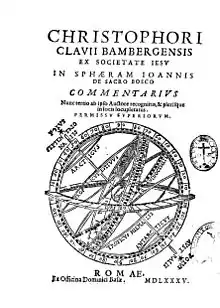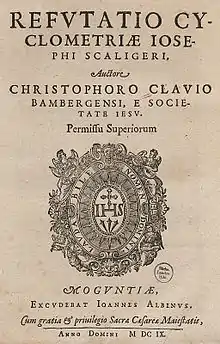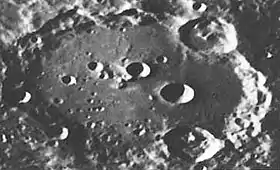Christopher Clavius
Christopher Clavius (25 March 1538 – 6 February 1612[1]) was a Jesuit German mathematician and astronomer who was a member of the Vatican commission that accepted the proposed calendar invented by Aloysius Lilius, that is known as Gregorian calendar. Clavius would later write defences and an explanation of the reformed calendar, including an emphatic acknowledgement of Lilius' work. In his last years he was probably the most respected astronomer in Europe and his textbooks were used for astronomical education for over fifty years in and even out of Europe.[2]
Christopher Clavius | |
|---|---|
 Christopher Clavius. | |
| Born | 25 March 1538 |
| Died | 6 February 1612 (aged 73) |
| Nationality | German |
| Alma mater | University of Coimbra |
| Known for | Gregorian calendar, Clavius' Law |
| Scientific career | |
| Fields | Mathematician, astronomer |
| Influences | Euclid Pedro da Fonseca Pedro Nunes |
Early life
Little is known about Clavius' early life other than the fact that he was born in Bamberg in either 1538 or 1537.[3] His given name is not known to any great degree of certainty—it is thought by scholars to have perhaps been Christoph Clau or Klau. There are also some who think that his taken name, Clavius, may be a Latinization of his original German name, suggesting that his name may have been Schlüssel (German for 'key', which is clavis in Latin).
Clavius joined the Jesuit order in 1555. He attended the University of Coimbra in Portugal, where it is possible that he had some kind of contact with the famous mathematician Pedro Nunes (Petrus Nonius). Following this he went to Italy and studied theology at the Jesuit Collegio Romano in Rome. In 1579 he was assigned to compute the basis for a reformed calendar that would stop the slow process in which the Church's holidays were drifting relative to the seasons of the year. Using the Prussian Tables of Erasmus Reinhold and building on the work of Aloysius Lilius, he proposed a calendar reform that was adopted in 1582 in Catholic countries by order of Pope Gregory XIII and is now the Gregorian calendar used worldwide.
Within the Jesuit order, Clavius was almost single-handedly responsible for the adoption of a rigorous mathematics curriculum in an age where mathematics was often ridiculed by philosophers as well as fellow Jesuits like Benito Pereira.[4] In logic, Clavius' Law (inferring of the truth of a proposition from the inconsistency of its negation) is named after him.
He used the decimal point in the goniometric tables of his astrolabium in 1593 and he was one of the first who used it in this way in the West.[5][6]
Astronomy

As an astronomer Clavius held strictly to the geocentric model of the solar system, in which all the heavens rotate about the Earth. Though he opposed the heliocentric model of Copernicus, he recognized problems with the Ptolemaic model. He was treated with great respect by Galileo, who visited him in 1611 and discussed the new observations being made with the telescope; Clavius had by that time accepted the new discoveries as genuine, though he retained doubts about the reality of the mountains on the Moon. Later, a large crater on the Moon was named in his honor.
Selected works

- Novi calendarii romani apologia. Rome, 1588
- Romani calendarii a Gregorio XIII P.M. restituti explicatio. Rome, 1603 (An explanation of the Gregorian calendar)
- Romani calendarii a Gregorio XIII P.M. restituti explicatio. (European Cultural Heritage Online)
- Romani calendarii a Gregorio XIII P.M. restituti explicatio. (University of Notre Dame)
- Commentary on Euclid, 1574
- Elementorum Libri XV. Cologne, 1627 (Published online by the Sächsischen Landesbibliothek - Staats- und Universitätsbibliothek Dresden)
- Treatise of gnomonics, 1581
- Refutatio cyclometriae Iosephi Scaligeri. Mainz, 1609
- Clavius, Christoph (1992). Corrispondenza Edizione critica a cura di Ugo Baldini e Pier Daniele Napolitani. Pisa: Università di Pisa – Dipartimento di Matematica. (Critical edition of his correspondence)
Clavius' complete mathematical works (5 volumes, Mainz, 1611-1612) are available online .
See also

- Asteroid 20237 Clavius
- Clavius (crater), a lunar crater named after Clavius
- Clavius Base, located in Clavius crater, in both the novel and film versions of 2001: A Space Odyssey
- Aloysius Lilius
- Computus
- List of Jesuit scientists
- List of Roman Catholic scientist-clerics
- Bracket (mathematics)
References
- ENCYCLOPEDIA.COM Clavius, Christoph
- "The books of Clavius were translated into Chinese, by one of his students Matteo Ricci "Li Madou" (1552-1610), and his influence for the development of science in China was crucial." Costantino Sigismondi, Christopher Clavius astronomer and mathematician
- The exact year is somewhat unknown and depends on when one assumes a new year begins.
- Amir Alexander (2014). Infinitesimal: How a Dangerous Mathematical Theory Shaped the Modern World. Scientific American / Farrar, Straus and Giroux. ISBN 978-0374176815., p. 69
- Apparently Francesco Pellos used the decimal point in his Compendio del Abaco already around 1492 but was much less known than Clavius. Jekuthiel Ginsburg, "On the early history of the decimal point", American Mathematical Monthly 35 (1928) 347–349.
- "Christopher Clavius", School of Mathematics and Statistics, University of St Andrews
- Ralf Kern, Wissenschaftliche Instrumente in ihrer Zeit. Cologne, 2010. pp. 254 – 255.
- James M. Lattis, Between Copernicus and Galileo: Christoph Clavius and the collapse of Ptolemaic cosmology. University of Chicago Press, 1994.
- Karl Christian Bruhns (1876), "Clavius, Christoph", Allgemeine Deutsche Biographie (ADB) (in German), 4, Leipzig: Duncker & Humblot, pp. 298–299
- Edmondo Lamalle (1957), "Clavius, Christoph", Neue Deutsche Biographie (NDB) (in German), 3, Berlin: Duncker & Humblot, p. 279
- Christoph Clavius, Corrispondenza, Edizione critica a cura di Ugo Baldini e Pier Daniele Napolitani, 7 volumes, Edizioni del Dipartimento di Matematica dell'Università di Pisa, Pisa, 1992
External links
 This article incorporates text from a publication now in the public domain: Herbermann, Charles, ed. (1913). "Christopher Clavius". Catholic Encyclopedia. New York: Robert Appleton Company.
This article incorporates text from a publication now in the public domain: Herbermann, Charles, ed. (1913). "Christopher Clavius". Catholic Encyclopedia. New York: Robert Appleton Company.- Christopher Clavius (1537-1612), The Galileo Project
- O'Connor, John J.; Robertson, Edmund F., "Christopher Clavius", MacTutor History of Mathematics archive, University of St Andrews.
- Materialsammlung zur Geschichte von Ingolstadt: Rita Haub: Christoph Clavius
- Online Galleries, History of Science Collections, University of Oklahoma Libraries—High resolution images of works by and/or portraits of Christopher Clavius in JPEG and TIFF formats
- Cristoforo Clavio in the Historical Archives of the Pontifical Gregorian University
- Project Clavius On The Web. A Web platform for the works and literature of Christophorus Clavius, CNR-IIT, CNR-ILC, APUG